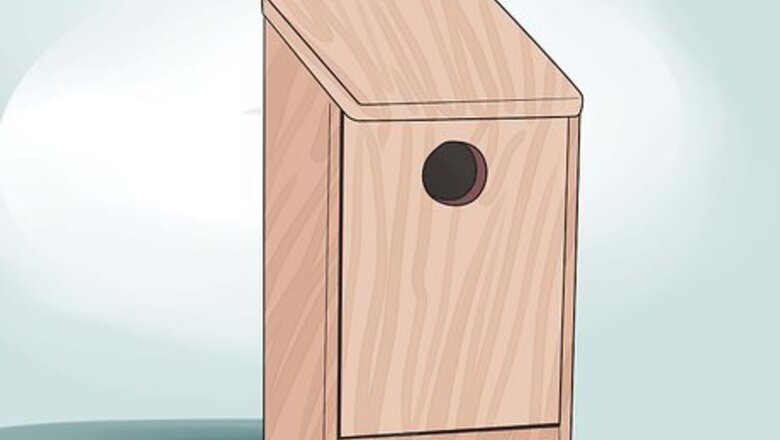
views
Raising Domestic Baby Birds
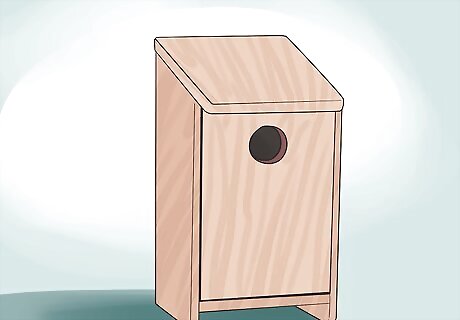
Create a nest box. If you are breeding birds, you should create a nest box before the female is ready to lay her eggs. Any wood box that is wide enough for the birds to turn around in and deep enough that the adults will not be able to kick all of the nesting material out of the box will do. Nesting boxes can be wood or metal. Wood provides more warmth, but metal is easier to clean. Fill the nest box almost to the top with pine or aspen shavings. The adults will probably kick some of the nesting material out, but this is fine as long as some remains. Secure the nest box on a baffled pole to keep predators away. Placing the nest box on the outside of the cage will make it easier for you to interact with the babies when they hatch. Once the eggs hatch, you will need to replace the soiled wood shavings on a daily basis.
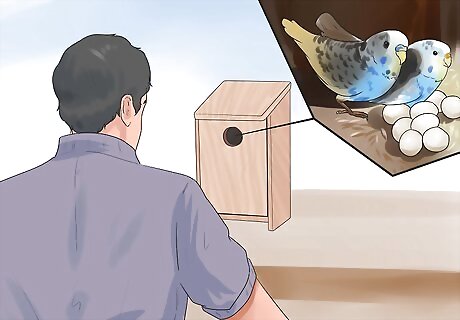
Keep an eye on the parents. Watch the parents carefully both before and after the eggs hatch. They are typically capable of caring for the babies, but you may need to intervene if the babies are in danger. If the parents are not sitting on the fertilized eggs, you may need to place the eggs in an incubator to help them hatch. If the parents are not feeding one of the babies, they may have rejected it because it is too weak. If this happens, you will probably need to take the baby away from the parents and raise it yourself. You can try reintroducing it to the parents after it has become stronger, but be sure to continue watching them closely. Be on the lookout for parents (especially fathers) who pluck the babies' feathers. This can mutilate or even kill the baby bird if done aggressively enough. If you notice this, move the parent to a different cage. You can try letting the parent visit the babies during feeding times, but only if it does not continue to pluck the babies' feathers.
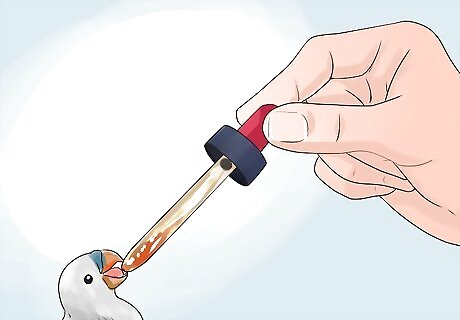
Decide if you will hand feed the babies. If you want to get your baby birds used to being handled by humans, you can begin hand feeding them at around two to four weeks of age, depending on the species. You can buy formulas that are specifically designed for the species of bird you are raising and feed them using an eye dropper, syringe, or spoon. The amount you feed them will depend on the birds' species and size. Be extremely careful not to feed baby birds anything that is too hot, or you may cause serious burns. The ideal formula temperature for cockatiels is 104-106 degrees Fahrenheit. You do not need to hand feed baby birds unless the parents do not appear to be feeding them. If you allow the parents to continue feeding them until they are weaned, the babies will develop better social skills to interact with other birds. If you start hand feeding them, they will become more tame around humans. Starting to hand feed baby birds before this time will probably not make any difference in their tameness. They will also miss out on the healthy bacteria that is introduced into their digestive systems by their parents in the first few weeks. If you do not hand feed the babies and allow the parents to continue feeding them, be sure to provide more seed and fresh foods than you normally would. If you notice the parents pacing around the cage, they may not have enough food. Be sure to clean any excess food off of the baby bird's feathers and out of its mouth using a sterile cloth or cotton swab and warm water. This will prevent bacteria buildup. You can also use a small amount of Citricidal to clean the feathers. Note that if you buy a bird at a pet store, it should be old enough to feed itself, so you will not need to hand feed it at all.
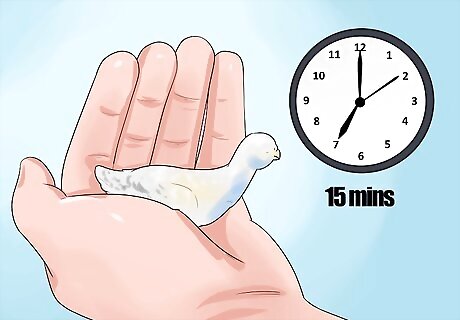
Handle the babies. Even if you choose not to hand feed your baby birds, you can still get them used to human contact simply by handling them regularly. Begin handling them several times a day for about 15 minutes per session, starting when they are about 12 days old. Always wash your hands thoroughly before handling the babies. They are very susceptible to bacteria when they are young. Handling the babies for too long will cause them to become cold and tired, so stick to short sessions. Give the babies lots of love by cradling them in your palms, stroking them, and talking to them.
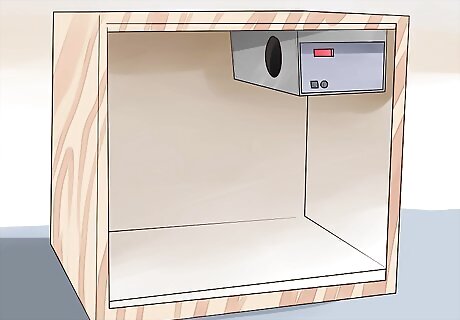
Use a brooder. If you want or need to raise the babies entirely away from their parents, you will need to use a brooder to keep them warm. You can set one up by placing a heating pad partially under the container you are keeping them in, and then covering the container with a towel to keep the heat in. The temperature should be 80-85 degrees Fahrenheit for babies that have pin feathers, 75-80 degrees Fahrenheit for babies that are fully feathered, and 65-75 degrees Fahrenheit for babies that are fully weaned. If you are using a heating pad to heat your container, be sure to place it only partially under the container so that the babies can escape the heat if it gets too hot. An aquarium makes and ideal container. You can also purchase special brooders or brooder tops that are designed to heat aquariums. Line your container with a soft material like toilet paper, paper towels, or cotton diapers. Be sure to change the lining material after each feeding. If you raise the baby birds away from their parents, it is best to allow them to socialize with them from time to time.
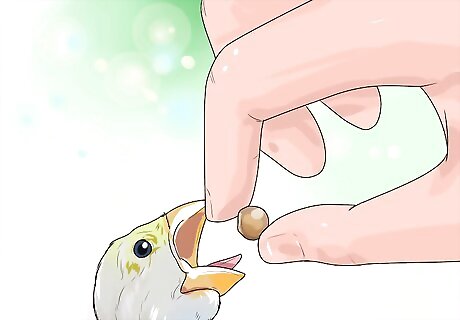
Wean the babies. Whether you have been hand feeding your baby birds or allowing the parents to feed them, you will need to start introducing them to weaning foods when they become old enough. The exact age will depend upon the species. You will know they are ready for weaning when they begin to pick things up with their mouths. Don't force the babies to wean if they're not ready. It may take several weeks for them to complete the transition. Be sure to continue hand feeding or allowing the parents to feed until the babies begin to refuse this type of feeding. If their necks are pumping and they are making noises, they are begging for food. You can buy weaning pellets to feed your baby birds during them time. You can moisten them to make easier to eat. You can also start introducing other soft foods, like fruits, vegetables, and cooked grains. If possible, move each baby to its own cage during the weaning process. This will result in optimal bonding with humans.
Deciding If a Wild Baby Bird Needs to Be Rescued
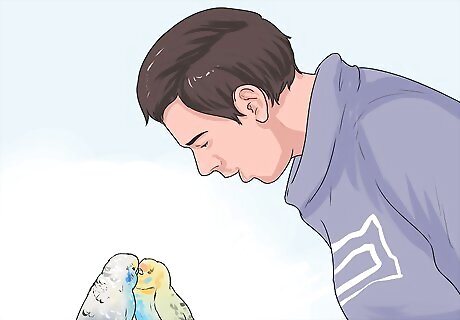
Understand what's best for the bird. In almost all circumstances, it is in a wild bird's best interest to be raised by its parents. Being raised by humans has numerous disadvantages for the bird, especially if you intend on releasing it back into the wild, so be sure not to intervene unless necessary. A bird that is raised by humans will miss out on important social interactions with other birds, and may not be able to pick up everything it missed. A bird that is raised by humans will not learn many of the survival skills its parents would have taught it, such as how to find food or how to spot a predator. This will decrease the bird's chances of being able to survive in the wild. A bird raised by humans is likely to exhibit no fear of humans, which could get it into trouble with people who are not familiar with the bird.
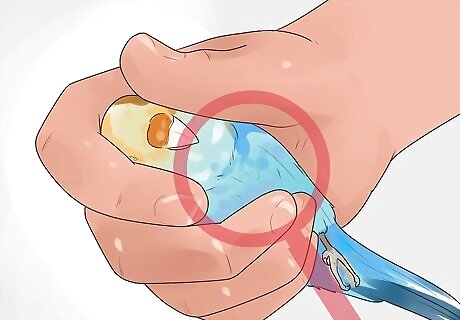
Check for injuries. Whenever you find a baby bird, you should determine whether it is injured. If so, contact a veterinarian or wildlife rehabilitator right away. Signs of injury include bleeding, wings that are drooping or twerked up, an inability to flutter its wings, shivering, and falling over. It is fine to handle the baby bird. It is not true that its parents will reject it if it has been handled by humans. Be sure to always wash your hands before and after handling a bird. If the bird was in another animal's mouth (like your cat or dog), you should assume that it is injured and get medical help for it. It may need antibiotics to protect it against dangerous bacteria acquired from the other animal, even if its skin isn't broken. Do not assume that a bird is injured just because it can't fly or seems slightly clumsy. Birds typically leave their nests before the are completely able to fly. This is a normal part of the learning experience for them.
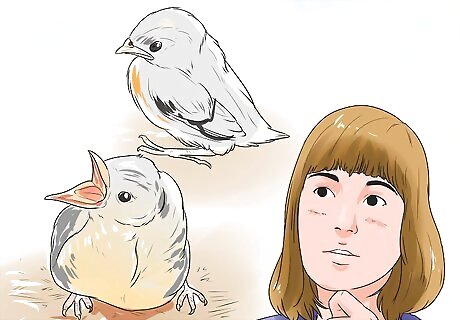
Determine if it is a nestling or fledgling. If you have determined that the bird is not injured, the next step is to determine whether it is a fledgling, which means it is learning to fly, or a nestling, which means it should still be in its nest. Fledglings may not be able to fly, but they should be able to grip firmly on your finger or another perch. Nestlings will not be able to do this. You can also identify a nestling by its lack of feathers. If you find a less than fully-feathered bird on the ground, it is probably too young to be there.
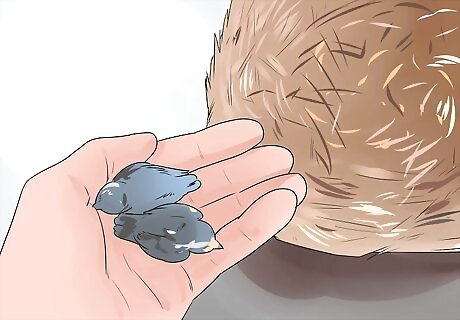
Return nestlings to the nest. If you have found a nestling that has fallen from its nest, the best possible thing you can do for the bird is to return it to its nest as soon as possible. Look in nearby trees and bushes closely, keeping in mind that the nest may be somewhat hidden. If you can't find the nest, you can create a new nest for the bird by placing it in a small basket or container and hanging it from or nailing it to a tree. Make sure the container has holes in the bottom for drainage and is lined with paper or cloth to prevent the bird from slipping.
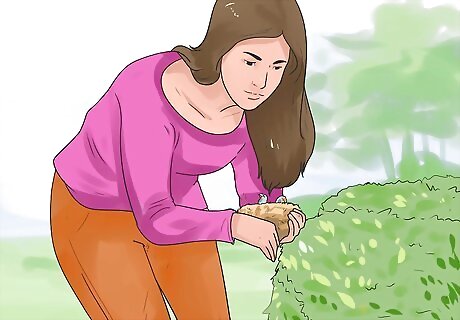
Remove fledglings from immediate danger. If you have determined that the bird you have found is a fledgling, you do not need to return it to its nest, but you should remove it from any danger that it might be in. This includes moving it out of a road or placing it in a tree if there are predators nearby. If the bird is not in immediate danger, there's nothing for you to do. Simply leave the bird alone and let it learn to fly. If you know that you have fledglings in your yard who are just learning to fly, try to keep your pets out of their way for a few days, and ask your neighbors to do the same.
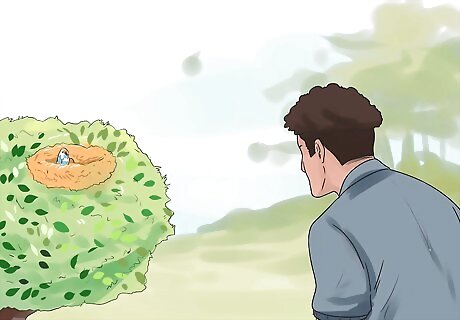
Keep an eye on it. If you have left a fledgling be or returned a nestling to a nest, you may still be concerned about it. If so, it's best to watch it from a distance. Its parents will not return to take care of it if you are there, so give the bird some space and wait to see if they come back for the baby. Parents should return to their babies within two hours, but they may not stay long. If you have been watching the bird and the parents do not return, you may consider intervening.
Caring for a Wild Baby Bird Temporarily
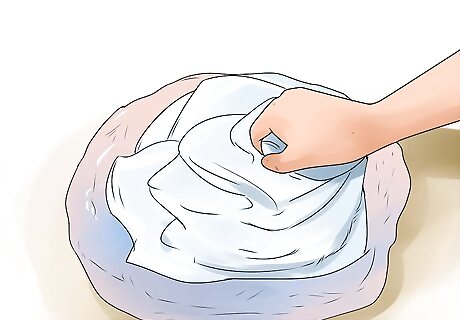
Create a safe nest. You will need to house your baby bird in some kind of small container. A small box or bowl will suffice. Be sure to line the nest with a soft material like toilet paper to make it more comfortable. Make sure there is enough bedding in the nest that the bird can prop himself up to defecate over the edge of the container. Keep the nest in a dark, quiet place. Too much light can damage the baby bird's eyes, and too much noise can scare it.
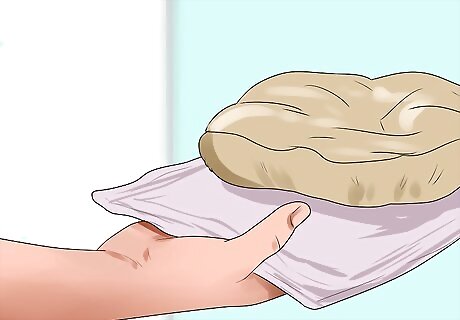
Keep it warm. If you are caring for a nestling, it is extremely important to make sure that it stays warm. You can do this by placing a heating pad under the bird's container and then covering it with a towel to keep the heat in. Keep the heating pad on low to avoid burning the bird. It is a good idea to leave at least a small portion of the container off of the heating pad so the bird can escape if it gets too hot. If you don't have a heating pad, you can fill an old sock with rice and microwave it until it is warm to the touch, but not hot. If you have a heating lamp, you can use this, with a 40 watt bulb placed at least 12 inches (30.5 cm) from the bird, as a heater. If you place the bird's nest inside an aquarium, you will simulate an incubator.
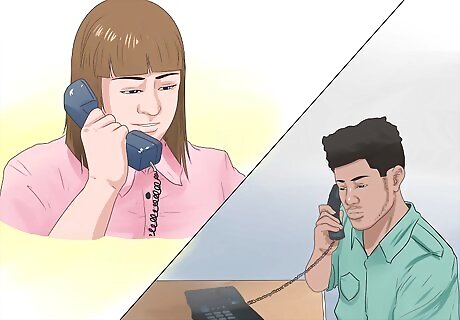
Contact a wildlife rehabilitator. Once you have made sure that the baby bird is safe and warm, contact a wildlife rehabilitator to finish raising it. A trained professional will be much better prepared to care for this baby bird than you will. It is important to understand just how labor-intensive it is to raise a baby bird when deciding whether or not to contact a wildlife rehabilitator. They need to be fed approximately every 30 minutes, so it is a very big commitment. If you can't locate a wildlife rehabilitator by searching online, you can try contacting your local game warden or conservation department. You can also try calling vets in your area. Even if they are not able to take the baby birds, they may be able to refer you to a local wildlife rehabilitator.
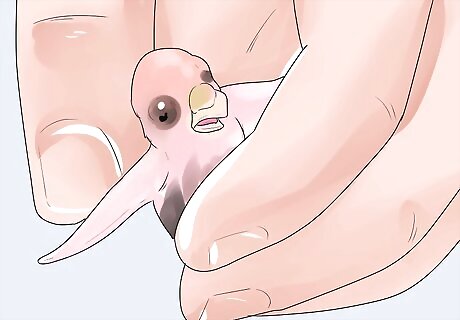
Consider offering food. The decision to provide food or water for your baby bird will depend on how long you must care for it before you can get it to a wildlife rehabilitator. If you do not need to provide food, it is best not to, as all birds have different dietary requirements, and feeding a bird the wrong thing can be very bad for it. If the bird has reddish skin or if you pinch the skin on the back of its neck and it doesn't spring back right away, it is probably dehydrated. If the bird is debilitated or dehydrated, do not attempt to provide food, even if it appears hungry. Never try to put water in a bird's mouth. The bird can aspirate the water and die. If you need to provide water, you can try giving it a small amount of dog kibble that has been soaked in water until it is soft.
Caring for a Wild Baby Bird Long-Term
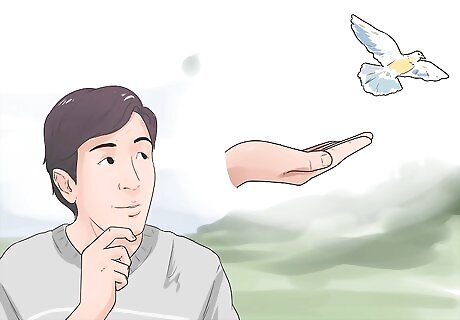
Decide if you will attempt to release the bird. It is important to decide from the beginning whether or not you will attempt to release the bird back into the wild from the very beginning. If you plan on keeping it as a pet for its whole life, you will probably want it to become tame, but if you are planning on releasing it, this tameness may inhibit its survival. If you plan on keeping the bird, handle it as you would any other pet. If you plan on releasing the bird, it is best to avoid handling it except when it is absolutely necessary. This means keeping children and pets away from the bird as well. A single baby bird under two weeks old will always imprint on its caretaker (see that person as its mother and become very attached), so it is best to surrender these birds to professionals who can care for them for the rest of their lives. If you have multiple baby birds, it may be possible to keep them from imprinting on you by staying away from them as much as possible. This will greatly increase their chances of survival in the wild. If you plan on releasing the bird, it's best to give it plenty of time outside, or at least in a place where it can see and hear the outside world. This will help it learn more about its environment.
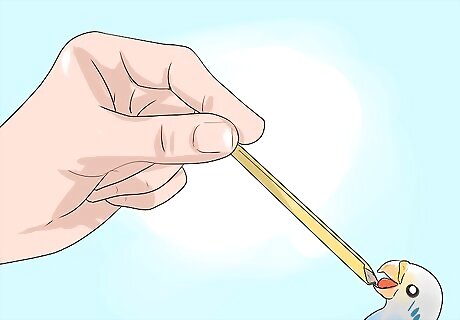
Provide food and water. Food and water requirements vary from species to species, so it is extremely important that you find out what kind of bird you are dealing with before you attempt to feed it. Once you have figured out what kind of food your bird needs, you can feed it by placing small amounts of food on the end of a drinking straw. Try cutting one side of the straw of at the end so that it resembles a scoop. Depending on the species of bird you are dealing with, you may feed it moistened dog kibble, seeds, or meal worms. If in doubt, ask a veterinarian what the appropriate diet for your bird would be. Never feed a bird bread or milk. Many birds get their water from the food they eat, rather than from drinking. The bird will be able to eat entirely on its own when it is between six and 10 weeks old, but you can begin providing small amount of food in the cage at four weeks to help it get used to the idea of self-feeding.
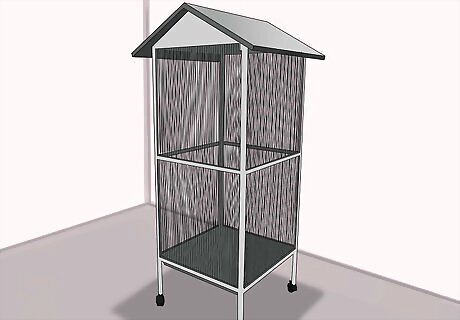
Get a cage. Once the bird is able to get out of its box, you will need to put it in a cage. Get as large of a cage as you can so your bird has room to move around. Try to expose your bird to sunlight, either by placing the cage outside for part of the day or by placing it near a window. If you cannot offer exposure to natural sunlight, try using an artificial sun lamp. Provide toys, like plastic wiffle balls, for your bird to play with. Perches are also important. Be sure to allow the bird enough time out of the cage to practice flying. The bird will not need any instruction, but it will need to work at it for a while in order to become a proficient flier.
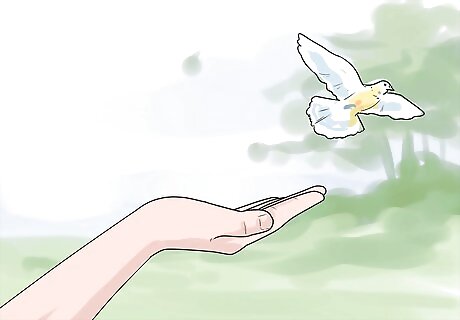
Release the bird. Once your bird is able to fly and eat on its own, you can consider releasing it back into the wild. Let the bird make the decision to leave the nest for good on its own. You can do this by bringing the cage outside and opening it, allowing the bird to come and go as it pleases. It may return to the cage the first few times or it may leave right away.













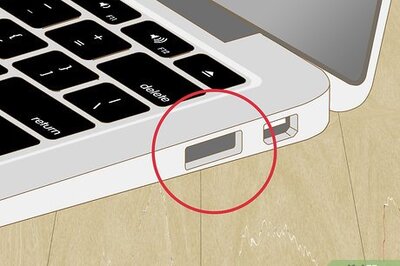
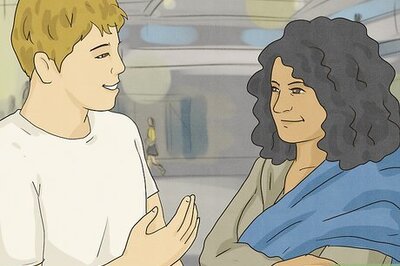
Comments
0 comment